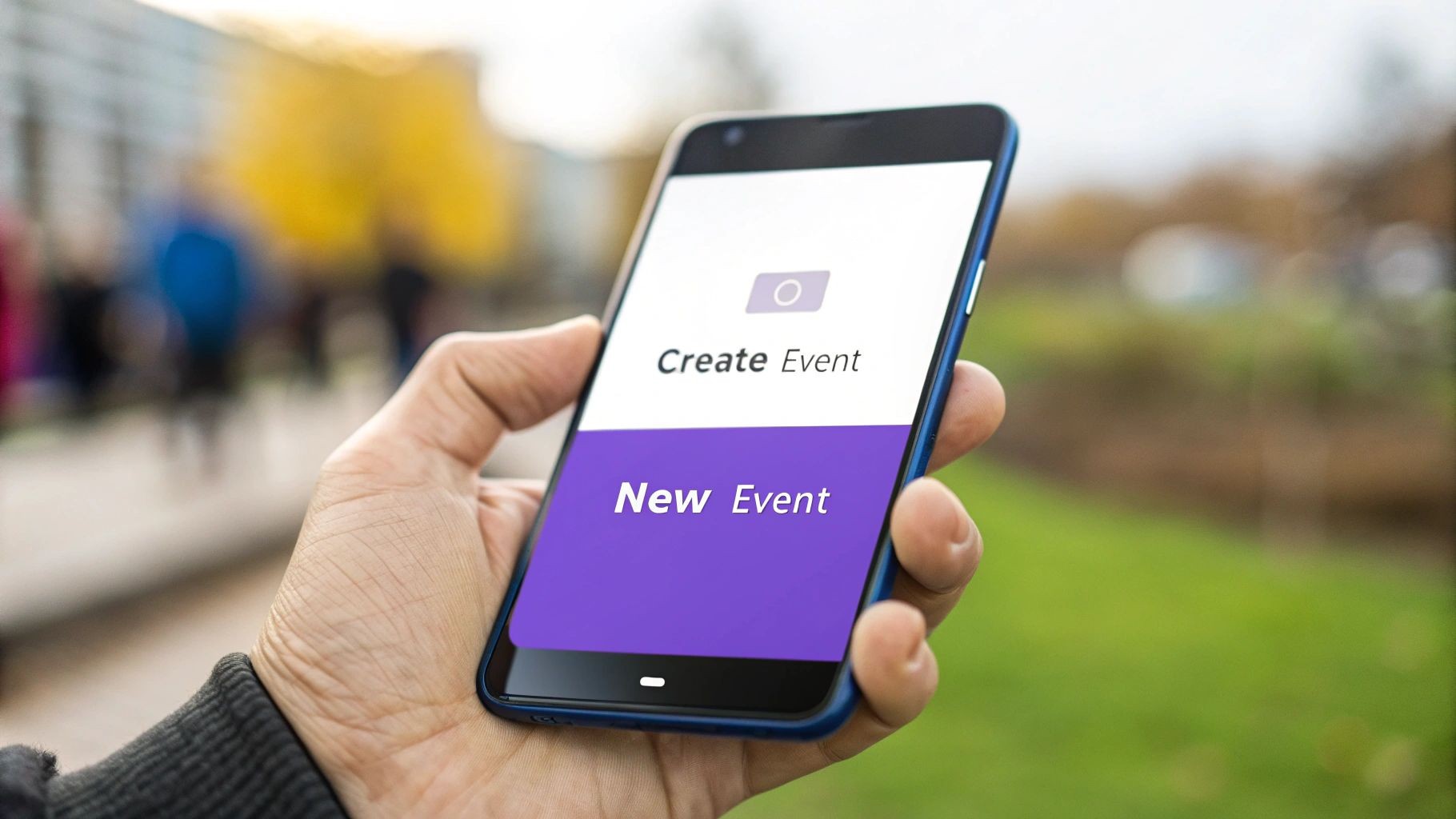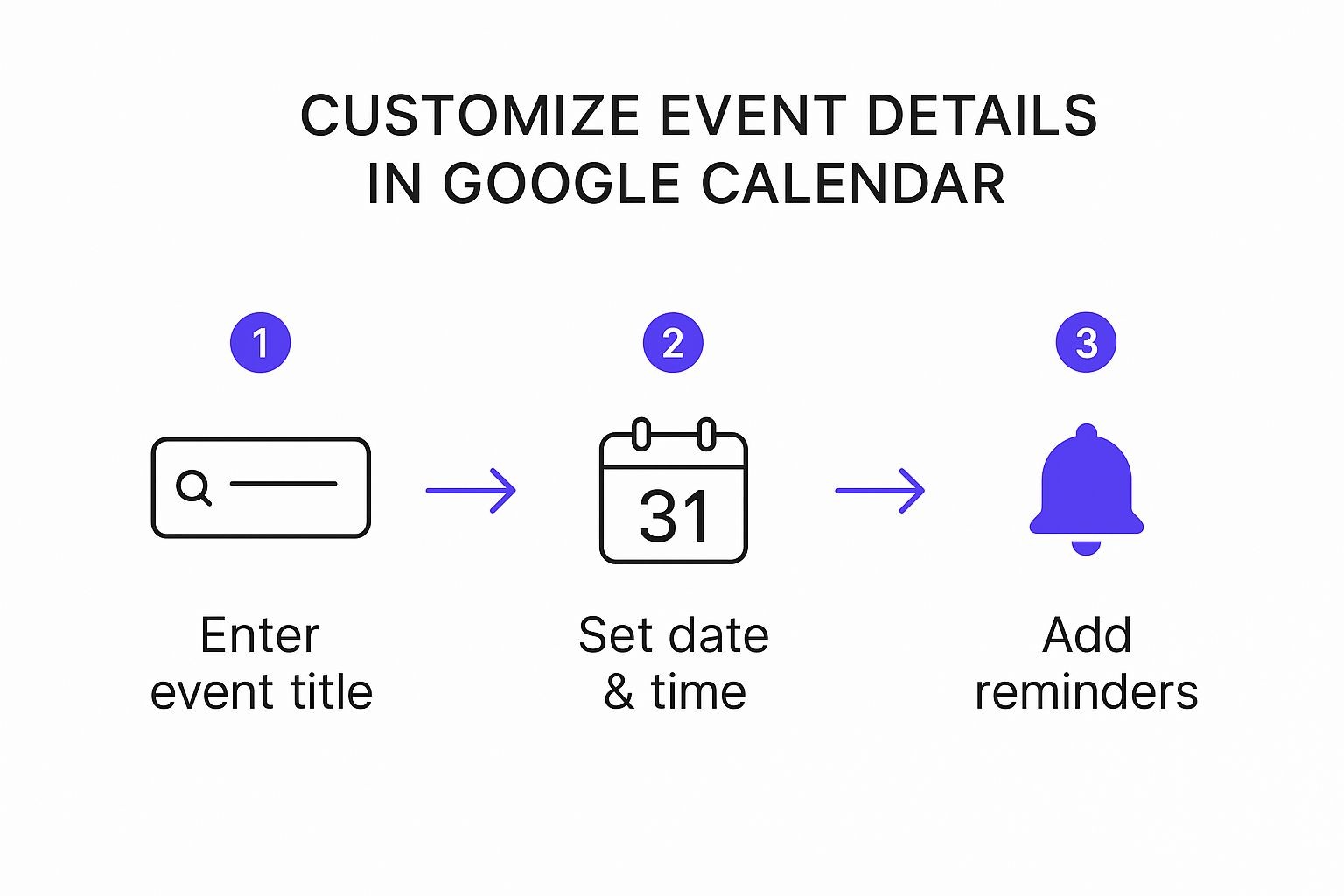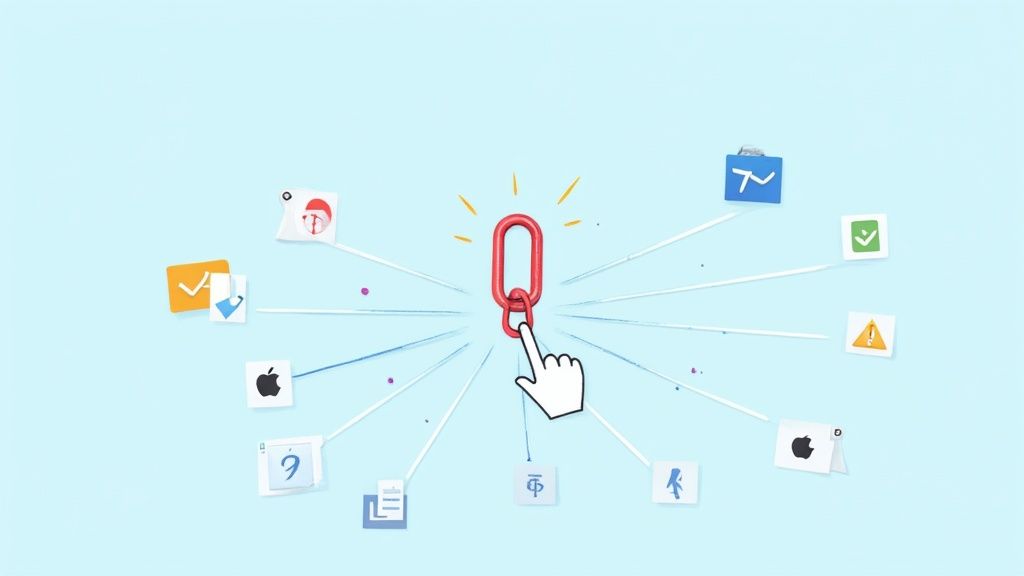Why Google Calendar Became Everyone's Scheduling Lifeline
Let's be honest, how many times a day do you hear (or say!), "Hold on, let me check my Google Calendar"? It's become the go-to for managing our schedules, and for good reason. From personal experience and chatting with others, I've realized a few key things that make it so indispensable.
The Gmail integration alone is a game changer. Think about it: flight confirmations, meeting invites - they all magically appear in your calendar. No more manual entry! This smooth process removes so much hassle, making scheduling a breeze.
Then there's the reminder system. Seriously, it's a lifesaver. I used to be notorious for missing appointments. Now, with custom reminders on Google Calendar, I'm rarely late. It’s like having a personal assistant nudging me along. That kind of reliability transforms a simple calendar app into a must-have tool. It’s not just about adding events; it's about weaving it into your daily workflow.
Sharing Is Caring (and Efficient!)
Another huge plus is how widely used Google Calendar is. Sharing calendars with coworkers, family, or even clients is super easy. This interconnectedness simplifies collaboration and minimizes scheduling conflicts. Ever tried coordinating a meeting across different calendar systems? It's a nightmare. Google Calendar's widespread adoption makes that a thing of the past. This is a big part of why it's so popular for both personal and business use.
The Numbers Don't Lie
Speaking of widespread use, Google Calendar boasts impressive stats. It's one of the most-used digital calendars globally, with over 1.2 billion monthly visits between January and March 2024. The average user session lasts over six minutes, showing how deeply integrated the app is into our routines. Discover more insights into Google Calendar’s usage. This level of engagement really speaks to how valuable the platform is for managing our increasingly hectic lives. While simply adding an event is a common task, the real power lies in its features and seamless integration with other tools.
Setting Up Your Calendar Foundation The Right Way

Before we jump into the fun stuff – adding events with Add to Calendar PRO – let's talk about setting up your Google Calendar properly. Trust me, I've seen so many people wrestling with their calendars, simply because they skipped this essential first step. It's like trying to bake a cake without preheating the oven – disastrous results guaranteed.
Taming the Notification Beast
Notifications. They can be a blessing and a curse. Too many, and you're constantly distracted. Too few, and you're missing crucial appointments. Finding the right balance is key.
Personally, I've found that disabling desktop notifications for most events works best. I lean on email reminders instead – it helps me stay focused. But for those really important meetings, I enable both desktop and mobile notifications. My advice? Experiment and find what keeps you on track without driving you crazy.
Time Zone Triumphs and Disasters
Ah, time zones. The source of many scheduling mishaps. I once scheduled a meeting with a client in London and completely forgot about the time difference. Let's just say it wasn't my finest moment.
Now, I'm a time zone fanatic, especially when working with international colleagues. Double-checking is a must. Thankfully, Google Calendar has some fantastic built-in time zone features. Get to know them – they’re lifesavers!
The Power of Color-Coding
Color-coding isn't just about aesthetics; it's a seriously powerful organizational tool. I use different colors for work meetings, personal appointments, and project deadlines. This gives me a clear visual overview of my day's priorities and helps me avoid overlaps. I even have a friend who color-codes by client – genius for tracking billable hours!
Privacy: Protecting Your Schedule
Sharing your calendar is essential for collaboration, but you don't need everyone seeing your entire schedule. Google Calendar offers granular privacy controls, letting you share only what’s necessary.
My tip? Create separate calendars for work and personal events. That way, you control who sees what, while still enjoying the benefits of shared calendars. This balance is crucial, especially when frequently adding events with a tool like Add to Calendar PRO.
Creating Events That Actually Work For You
Adding events to Google Calendar is more than just clicking "Create." After wrangling countless schedules, I've learned what separates the calendar pros from the amateurs. Think about it: writing event titles that still make sense months later, using location features that play nice with your travel apps, and managing guests so people actually show up. It's a whole science.

This three-step process – title, date/time, and description – is the foundation of every event. It's the bare minimum, but we're aiming higher. We want events that work for us.
Mastering Different Event Types
Different events have different needs. Recurring team meetings? Setting them to automatically skip holidays is a lifesaver. All-day events? There’s a trick to keeping them from cluttering your daily view. And notifications? Forget constant pings. I used to be drowning in them. Now, I only get alerted for the truly important stuff. Focus is key.
Leveraging Add to Calendar PRO
When you're juggling a lot of events – especially promotions – efficiency is paramount. That's where Add to Calendar PRO comes in. Its lightweight buttons embed on any website, automatically creating those reliable ICS files and handling tricky time zone adjustments. No more back-and-forth emails or confusion about event times. Trust me, I've been there.
The built-in RSVP management is a game-changer too. Custom form fields and GDPR-compliant double opt-in flows mean you can collect attendee information seamlessly. No more separate signup forms. It’s simpler for everyone, and you get valuable data to boot.
Making Your Events Discoverable
Add to Calendar PRO also generates SEO-optimized landing pages with structured data and social preview images. Suddenly, your events are shareable, discoverable, and engaging. I’ve seen firsthand how this boosts visibility in today’s crowded online world. Adding an event to a calendar isn't just a task; it’s a marketing opportunity.
The platform’s customization options are fantastic. Even if you're not a coder, you can adjust styles, text, and integrations. From small workshops to huge conferences, Add to Calendar PRO offers a complete solution. It elevates adding events to Google Calendar from a chore to a strategic part of your overall communication plan.
Let's talk strategy. I've put together a table comparing different event creation methods, based on my own experience and what I've seen work best:
Event Creation Methods That Actually Make Sense
Creation Method | Best Use Cases | Time Investment | Available Features | Mobile Experience |
|---|---|---|---|---|
Manual Entry (Google Calendar) | Simple, one-off events | Low | Basic scheduling, reminders | Good |
Importing ICS Files | Sharing events with others, importing from other platforms | Medium | Varies depending on the ICS file | Can be clunky |
Add to Calendar PRO Buttons | Website event promotion, seamless user experience | Low | Time zone conversion, RSVP management, custom branding | Excellent |
Calendar Subscriptions | Ongoing series of events (but use with caution!) | Low (initial setup) | Automatic updates (but can be overwhelming) | Can lead to clutter |
This table highlights the trade-offs between different approaches. Manual entry is fine for simple events, but it doesn't scale. ICS files are good for sharing, but the mobile experience can be rough. Calendar subscriptions can quickly become unwieldy. Add to Calendar PRO hits the sweet spot for most scenarios, especially when you want a smooth user experience and powerful features.
Advanced Features That Transform Your Calendar Game
So, you've got the basics of adding events down. Great! Now, let's dive into the really cool stuff that makes Google Calendar a productivity powerhouse. These are the features that separate the casual planners from the true calendar ninjas.
Recurring Events: Beyond the Basics
Recurring events are essential, sure. But setting them up smartly is where the magic happens. Take those weekly team meetings, for example. Do you really need reminders pinging everyone during vacation? I learned this the hard way and now configure my recurring events to automatically skip holidays and vacation days. Trust me, it saves everyone from notification overload.
Add to Calendar PRO also makes recurring events easier for your attendees. They get a clean, accurate entry on their calendar app, no confusing duplicates.
Calendar Layering: Organized Chaos
I used to have one massive, overflowing calendar. Work, personal stuff, projects - it was a digital disaster. Then I discovered calendar layering. Life-changing.
Now I have separate calendars for each area of my life. I can toggle them on and off, focusing on what's important at that moment. It's like having multiple personalized views without losing sight of the big picture.
This is especially helpful with Add to Calendar PRO. You can assign event categories to different calendars, automatically organizing everything. Imagine managing several webinar series, each neatly tucked into its own calendar. Pure bliss.
Gmail Integration: Automation at Its Finest
Gmail and Google Calendar integration is about so much more than meeting invites. I'm talking flights, hotel bookings, even dinner reservations. Those confirmations automatically appear in my calendar. It's practically magic. Add to Calendar PRO enhances this integration, making sure those crucial event RSVP details land directly in your Google Calendar.
Collaboration Features: Team Scheduling Made Easy
Team scheduling can be a real pain. Endless email chains trying to nail down availability… shudders. Google Calendar's collaboration features - shared calendars and delegation - make this so much smoother.
Sharing a team calendar for project deadlines or client meetings eliminates confusion. And delegation? Empower your team to manage their schedules within set parameters.
Add to Calendar PRO elevates collaboration even further. Attendees can add events directly to the right team or project calendar, no special access permissions needed. Everyone stays in sync, and you save tons of administrative time. Now that's teamwork.
Professional-Grade Calendar Management For Serious Users
When you're juggling complex schedules across multiple teams, time zones, and even organizations, the enterprise features of Google Calendar become essential. I've personally witnessed how large organizations use it to coordinate massive events, and it's quite a sight. They’re not just adding entries; they're conducting a logistical symphony.
Streamlining Large-Scale Coordination
Picture a large company organizing a multi-day conference in multiple countries. Booking venues, managing speakers, and coordinating attendee schedules could easily spiral into chaos. Google Calendar, paired with tools like Add to Calendar PRO, offers real solutions. Think dedicated calendars for each session track, automated email reminders for attendees, and real-time updates for any changes – it’s all within reach.
Speaking of widespread use, Google Workspace (which includes Google Calendar) boasts roughly 3 billion active monthly users. Major players like Salesforce, Airbus, and Equifax rely on it, highlighting just how critical Calendar is for effective event management. Discover more insights into Google Workspace’s impact. This level of adoption really speaks for itself.
Powering Up With Google Workspace Integration
The true magic lies in Google Workspace integration. Consider the potential: connecting your calendar with other productivity tools. Imagine automatically generating a Google Meet link for every scheduled meeting, or syncing tasks directly from your project management software into your calendar. This is where calendar management becomes truly professional-grade. I’ve collaborated with teams who have built entire workflows around this integration, and it's a complete game-changer.
Real-World Implementation and Troubleshooting
Naturally, even with the best tools, you might encounter some bumps in the road. That's why learning from others who've successfully implemented Google Calendar at scale is so valuable. I've gathered some fantastic tips from productivity consultants who have guided organizations through these complexities. A common pitfall is notification overload. While reminders are crucial, too many can lead to alert fatigue. Striking the right balance is key.
Another frequent hurdle is managing shared calendar permissions. Granting excessive access can result in accidental modifications, while overly restrictive permissions can hinder collaboration. Clearly defined roles and responsibilities regarding calendar access are essential. To take your calendar management to the next level, explore some helpful live event technology tips. This will give you fresh perspectives on managing events within your calendar. These practical strategies and troubleshooting tips are drawn from real-world scenarios, and they can significantly boost your ability to maximize Google Calendar’s power.
How Google Calendar Stacks Against The Competition
Let's be honest, Google Calendar isn't perfect. It's the go-to for many, but it's worth checking out how it compares to other scheduling tools and understanding its limitations. This comes from actually using these platforms day in and day out, not just reading about them.
Why Google Calendar Still Reigns
One of Google Calendar's biggest strengths is its huge user base. Sharing schedules is super easy because practically everyone's already on it. This interconnectedness saves you the hassle of dealing with different calendar systems. Plus, it's free, which is a major plus for a lot of people. You know, when I'm juggling my Google Calendar, I sometimes find social media management tools helpful for keeping everything organized.
However, this simplicity can also be a limiting factor. For more complex scheduling, it can feel a bit restrictive. Features like recurring events and reminders are useful, sure, but they sometimes lack the flexibility of more specialized tools. The digital calendar market is booming, with Google Calendar at the forefront. For example, Calendly has over 20 million users and 100,000 businesses, but it's mainly US-focused. Google Calendar, on the other hand, boasts over 1.2 billion monthly visits globally. It's interesting to see the trends in the growing digital calendar market.
When Specialized Tools Shine
Where Google Calendar falls short, specialized scheduling tools really shine. Services like Calendly offer powerful features like automated booking, personalized scheduling links, and payment integrations. These are game-changers for businesses handling appointments, consultations, or workshops. I've personally seen businesses make the switch specifically for these features – the streamlined client experience and robust booking functionalities are a huge draw.
Before we go further, let's look at a quick comparison of some popular calendar platforms. This table is based on my own experiences and some practical testing across different scheduling scenarios.
Calendar Platform | Global User Base | Integration Ecosystem | Team Features | Pricing Reality |
|---|---|---|---|---|
Google Calendar | 1.2B+ monthly visits | Extensive, integrates with most Google services and many third-party apps | Basic shared calendars, event invitations | Free |
Calendly | 20M+ users | Focused integrations for scheduling and business tools | Automated booking, customized links, payment integrations | Paid plans, limited free tier |
Outlook Calendar | Part of Microsoft 365, large user base | Strong integration within the Microsoft ecosystem | Shared calendars, meeting scheduling, team collaboration features | Typically bundled with Microsoft 365 subscriptions |
Apple Calendar | Default calendar app for Apple devices, large user base | Tight integration within the Apple ecosystem | Shared calendars, event invitations, iCloud syncing | Free |
As you can see, each platform has its strengths and weaknesses. It really boils down to what you need from a calendar.
Finding the Right Balance
The best calendar solution really depends on your individual needs. For basic personal scheduling and simple team coordination, Google Calendar is often more than enough. But if you’re managing a lot of appointments, need advanced booking features, or require deeper integrations with other business tools, a dedicated scheduling platform might be a smart investment.
I've noticed many people actually use both – Google Calendar for personal stuff and general work scheduling, and a specialized tool for client bookings or specific projects. This hybrid approach gives you the best of both worlds. The key takeaway? Don’t be afraid to try different things and find what works best for your workflow.
Your Personal Roadmap To Calendar Mastery
Let's turn all this Google Calendar info into a practical plan you can actually use. Think of this as your personalized guide to scheduling mastery, built on feedback from real users who've been there and conquered their calendars. Whether you're juggling personal appointments, team projects, or complex business operations, we've got advice tailored to you.
This screenshot shows a standard Google Calendar view. See how easy it is to navigate between daily, weekly, and monthly views? That clear interface lets you visualize your schedule and add events quickly. But the real magic lies in the customization options and integrations that make Google Calendar so adaptable.
Building Your Calendar Command Center
For personal use, mastering notifications is key. I started by silencing less important notifications. No more constant buzzing for every little thing! Instead, set up custom reminders for critical appointments. I like email alerts for most things, but I rely on mobile notifications for those can't-miss events. This keeps me informed without feeling overwhelmed.
Color-coding is another game-changer. Assign specific colors to different event categories – work, personal, projects, you name it. This visual organization makes scanning your schedule a breeze and helps you catch potential conflicts fast. I've even seen people color-code by client, a brilliant trick for tracking billable hours.
Team Scheduling Success Strategies
For teams, shared calendars are your best friend. Create dedicated calendars for specific projects or client groups, making sure everyone has the right access permissions. This keeps scheduling information centralized and cuts down on those endless email chains.
Another powerful tool? Event delegation. Empower your team members to manage their own schedules within pre-set guidelines. This frees you up to focus on the bigger picture. Add to Calendar PRO really streamlines this by letting attendees add events directly to the right team calendar, no special access needed.
Mastering the Business Calendar Battlefield
When it comes to complex business calendars, exploring Google Workspace integrations is a must. Connect your calendar with other productivity tools to automate your workflows. Think automatically generating Google Meet links for every meeting or syncing tasks from your project management software.
For even more advanced features, check out Add to Calendar PRO. Things like custom RSVP forms and automated landing pages take event management from a logistical headache to a marketing opportunity. The ability to customize the platform to your exact needs ensures you're squeezing every drop of value out of your scheduling efforts. You can collect attendee info smoothly, stay GDPR compliant, and create SEO-optimized event pages. It’s a complete solution for managing and promoting your events.
Ready to level up your scheduling? Start your free trial of Add to Calendar PRO today!



